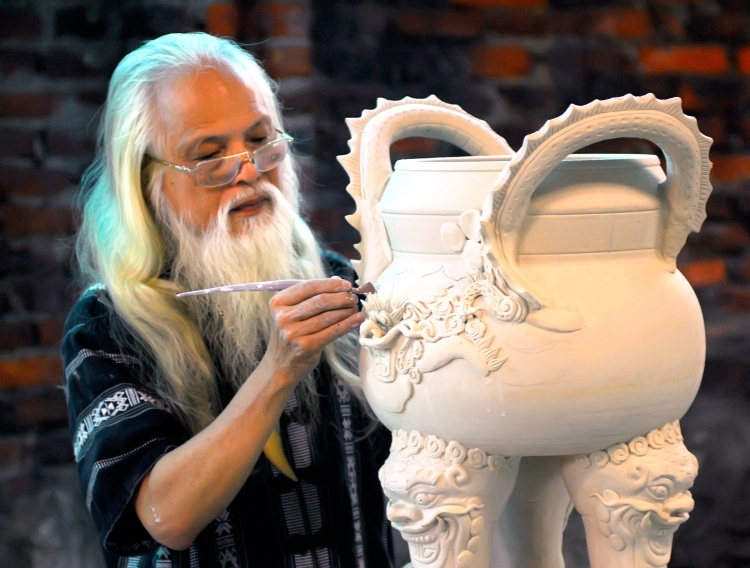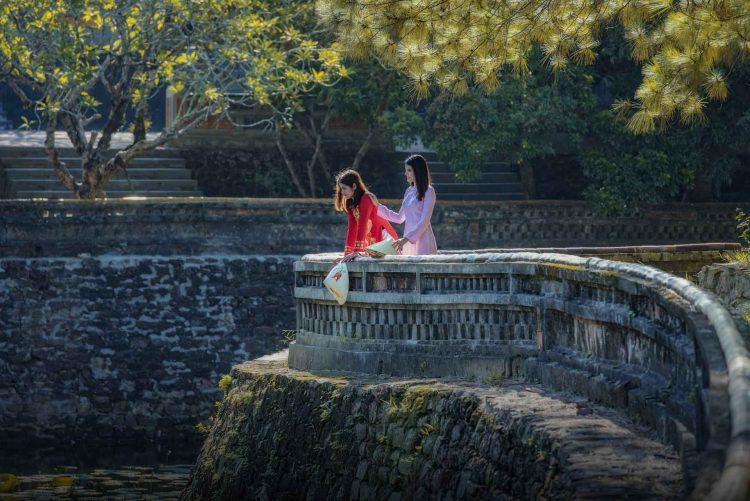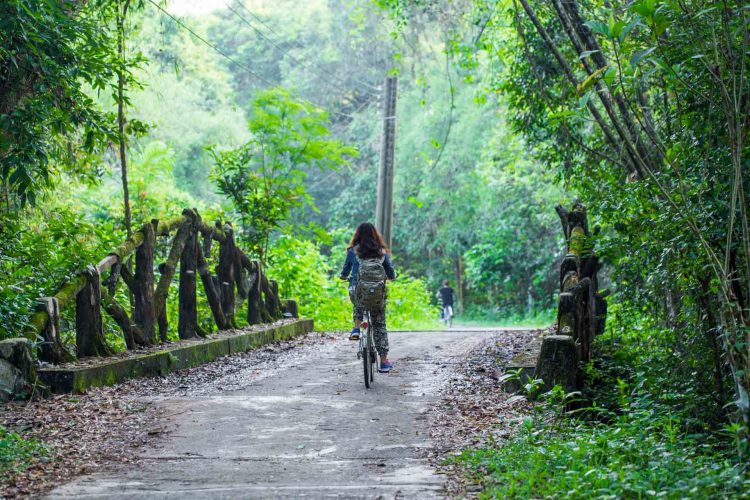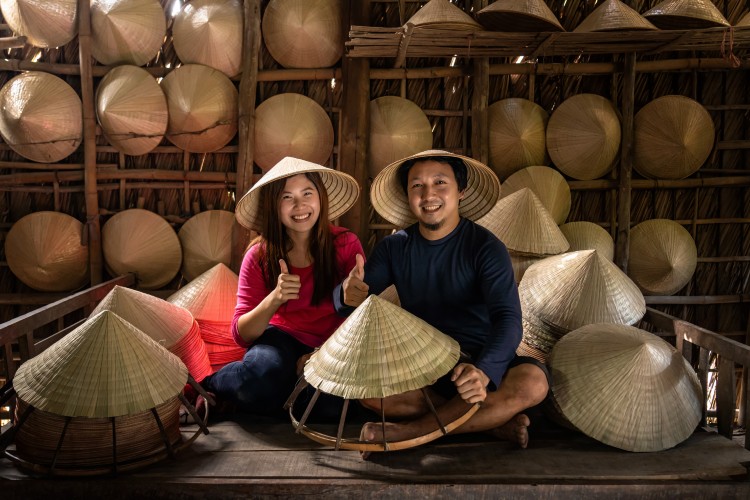Not only is Vietnam the land of awe-inspiring landscapes, it also possesses a long-lasting tradition and culture. Along this S-shaped land, there exist several cultural villages with the history dating back to centuries ago. If you are about to take a tailor-made Vietnam cultural tour, the following destinations would be ideal for you.
1. Bat Trang Pottery Village – the must-see for any Vietnam Cultural Tour.
 Source: Lux Travel DMC
Source: Lux Travel DMC
Undoubtedly, any north Vietnam cultural tour will never be complete without a visit to Bat Trang Pottery Village. It is only 13 km to the southeast of Hanoi, so don’t miss it out when traveling there.
As its name suggests, the village has a long-lasting tradition in making ceramic products. In documents, the history of Bat Trang Village dates back to the 15th or the 16th century. However, local people believe the village appeared much earlier. Legend has it that during the Ly Dynasty, the Emperor sent scholars to China to learn how to make pottery and they then came back to teach the locals in Bat Trang the technique. The artisans here could create exquisite ceramic products, from household furnitures like cups, bowls, and teapots, to garniture like vases and lightings. The goods from Bat Trang Village has captured not just domestic attention but also worldwide interest.
Taking a village tour to Bat Trang, visitors will be able to understand more about the historical and traditional values of the village as well as its exquisite products. There will be classes where you could learn about the process of making ceramics, also.
2. Duong Lam Village – The Oldest Village in Vietnam
 Source: Lux Travel DMC
Source: Lux Travel DMC
Located 40 km to the west of Hanoi city center, Duong Lam is the oldest village of Vietnam. It is an appealing destination for a Vietnam cultural tour with the typical features of an old northern village, which has remained the same after centuries.
Duong Lam is also the hometown of two Vietnamese Kings: Phung Hung (761-802) and Ngo Quyen (896-944). Both figures led resistance wars against the Chinese invasion and became the Kings of ancient Vietnam Dynasties.
It’s hard to believe that there still exists such an ancient village just around 40 km from the busy city. Many of the houses in the village are up to 400 hundred years old, from which you can see the typical architectural features of a rural house in the northern countryside like the lateritic brick wall and the big wooden pillars. Other highlights of a typical northern hamlet are also well preserved like the communal house, the village gate with huge banyan tree, and the rice paddies.
Duong Lam also bears a significant spiritual and religious value. It is home to the ancient Mia Pagoda and the temples that worship the Emperors. Vietnamese people from different regions often flock to these places to tribute their heroes and pray for a happy, healthy, and prosperous year.
Duong Lam Ancient Village is a perfect destination for a getaway from the bustling city life. Visitors will feel like you are driving back to centuries ago when feeling the tranquility and nostalgia in this village. Paying a visit to the old houses and imagine the life of the locals via the stories of the elderly, or wander in the rice paddies to breathe the fresh air, you will be able to release all the stress and fatigue of the city life.
Also, do not forget to sample the village’s specialties. “Kẹo dồi”, “kẹo lạc” (types of peanut candies), and “chè Lam” (a chewy candy made from glutinous rice) are three must-try when traveling there. Despite being made from simple ingredients, they are heavenly tasty and would be great snacks to eat along the way.
3. Van Phuc Silk Village – The Origin of Renowned Ha Dong Silk
Apart from the two famous destinations above, Hanoi still has many things to offer. Van Phuc Silk Village is another traditional village in Hanoi suburb that culture lovers should visit during their Vietnam cultural tour.
Van Phuc Village is situated next to Nhue River, which is about 10 km far from the city center. It is home to the famous Ha Dong Silk – the top-notch silk of Vietnam in particular and Asia in general.
Its tradition dates back to hundreds of years ago. Ha Dong Silk was the special material that the tailors used to make costumes for the King and his royal families under Nguyen Dynasty. The silk is famous for its lightweight, elegance, and smoothness. Hence, it is the ideal material to make the traditional “ao dai” of Vietnamese women. In the past, except the royal and mandarin families, only the well-off could afford to buy Ha Dong Silk to make clothes.
In the 20th century, Van Phuc silk became even more prestigious when the French traders considered it the most sophisticated products of Indochina (Vietnam, Laos, and Cambodia today).
A tour to Van Phuc Village will allow visitors to learn about the silk-making tradition of the villagers. The multi-color of several silk products displayed along the streets will definitely amaze you. And don’t forget to buy home the first-class silk or order a tailor-made “ao dai” here.
4. Cat Cat Village – A closer approach to tribal people’s life.
 Source: Lux Travel DMC
Source: Lux Travel DMC
If you are wondering what to do in Sapa, pay a visit to Cat Cat Village. It lies under the marvelous Hoang Lien Son Mountain Range, which is only 5 minutes driving from the town of Sapa.
During the 19th century, people from different groups, namely the black H’Mong, gather together and form a new community. They built houses on the ridge of the mountains and each rooftop would be tens of meters apart. The locals earn a living by cultivating crops right on the surrounding hillsides.
Additionally, H’Mong people still preserve some traditional handicrafts such as weaving brocade and making silver and bronze jewelry. The brocade is used to make traditional clothing, which plays an integral part in the spiritual life of the locals.
A custom-made Vietnam cultural tour to Cat Cat Village is not just about traveling to a remote hamlet. It’s a great combination of sightseeing and culture exploring. Your jaw will drop when the picturesque scenery of the village appears in front of your naked eyes. Wandering around the village, you will see the beautiful little houses on the mountainsides, the men farming on the terraced fields, the women weaving looms, and the kids playing jauntily. These simple things altogether make up a harmoniously quaint scene that you cannot help falling in love.
5. Dong Ho Painting Village – A look at ancient Vietnam Fine Arts.
For people that are in love with traditional paintings and arts, Dong Ho Painting Village is the best option for your Vietnam cultural tour. Its traditional folk paintings are one of the most outstanding representatives of ancient Vietnamese fine arts.
Dong Ho Woodcut Painting is an invaluable intangible heritage of Vietnamese culture. Having survived for tens of centuries, Dong Ho Paintings depicts myths, Vietnamese folk allegories, wishes and hopes, social activities, and so on. It is the special way of northern people to reflect their aesthetic value as well as significant social philosophies.
Dong Ho Paintings used to be an indispensable item for Tet Holiday in every northern Vietnamese family. Because it is often hung on such an important occasion, the themes are mostly humorous with a bright color.
To make a painting, the artisan would carve the content onto a flat wooden block first. Then, he will brush a layer of ink onto it and stamp them on a “giấy gió” paper. This special paper is made from bark tree and could retain colors for years.
Dong Ho Painting Village is only about 35 km from Hanoi city center. It takes only 1 hour to drive there, so be sure not to miss it out!
6. Vung Vieng Fishing Village – the floating world amidst the ocean.
 Source: Lux Travel DMC
Source: Lux Travel DMC
Next is about a floating village that exists amidst the majestic Halong Bay. The only way to approach this village is through a limestone arch gateway.
Vung Vieng fishing village is the home of up to 50 families, who make up a population of more than 200 people. The houses are connected to each other to stay strong against the storms and other disasters. The villagers on Vung Vieng earn a living by catching fish and cultivating pearls. Tourism activities give them some money, also. Every person living in this floating village is good at swimming because it is the only way that could help them survive amidst the ocean.
Vung Vieng is now on the itinerary of many Halong Bay cruises. A trip to this place will enable tourists to learn how the daily life of the locals would pass. You can approach the village by using the locals’ bamboo boats or paddle the kayak yourself. The people here are very hospitable. They always welcome passengers with their warmest hearts.
Additionally, spend some times to learn how to make pearls. Halong pearls are famous as the top-notch pearl in Vietnam thanks to its shiny and smooth appearance. You could learn the process of cultivating this luxury item with the locals here.
7. Phuoc Tich Village – the typical Central countryside.
 Source: Lux Travel DMC
Source: Lux Travel DMC
If Duong Lam Village is typical for the northern countryside, Phuoc Tich Village is where visitors could have a glimpse into the tradition of Central people. Phuoc Tich Village lies along the bank of O Lau River in Phong Dien District, which takes only half an hour to drive from Hue. It is an ideal place for an outing during your luxury Hue tour.
Phuoc Tich Village seems to be totally isolated from the bustling world outside. There is no sign of high-rise buildings, the noise of vehicles on the streets, or the smoke from any factories. Instead, there are green hedges and large foliage of the trees along the village’s roads. There still exist some old “Ruong” houses which date back to hundreds of years ago. It is the typical house type of ancient Hue people.
The village well preserves the integrity of an ancient trade village, with a system of communal houses, pagodas, temples, shrines, and “ruong” houses. Especially, as it has a long-lasting tradition in making kiln, the details on their houses and roofs are made up of thousands of small kiln pieces.
With the exceptional tranquility and quietness it offers, Phuoc Tich Village deserves to be a top destination for a Vietnam cultural tour. Let’s leave all your stress and sorrow behind and use the poetic and peaceful vibe here to ease your mind.
8. Phu Vang Conical Hat Village – the birthplace of “non la”.
 Source: Lux Travel DMC
Source: Lux Travel DMC
Together with “ao dai”, “non la”, or the conical hat, is a symbol of traditional Vietnamese girls. A trip to Phu Vang Conical Hat Village in Hue will hence allow you to learn how to make this beautiful item.
Phu Vang District is home to several traditional conical hat making villages. It is where “nón bài thơ” (conical hat with a poem on it) – the special Hue variant of “non la” was born. “Non bai tho” has been closely linked to the image of Hue girls, who are famous for their elegance and beauty.
The male villagers are responsible for collecting leaves and making the frames for the hat while the female, with their delicate hands, would make up excellent pieces of hat. Women in these traditional villages start to learn how to make a conical hat ever since they are still teenagers.
A tour to Phu Vang Village will enable tourists to both enjoy the peaceful vibe of the countryside and learn about the process of making a conical hat. Remember to buy home a hat to match with “ao dai”. They are definitely a perfect match!
9. A Vietnam Cultural Tour to Tuyet Diem Salt-making Village.
 Source: Lux Travel DMC
Source: Lux Travel DMC
People in Tuyet Diem has started to make salt for more than 300 years. It is one of the three biggest salt villages in Phu Yen Province. Tuyen Diem is a promising place for those wanting to explore the tradition of the people in the southern coastline.
Tuyen Diem Salt is also called Cu Mong Salt, basing on the name of the nearby pass. The locals explain that it is because in the past, traders from other places must come to the village to buy salt from Cu Mong Pass’s direction. The village is famous for its exceptionally white salt, which is of the best quality in Vietnam.
The locals spend most of their time on the salt field. They can only produce salt on sunny and hot weather. In other words, they can only work on the field in a few months of summer. For the rest of the year, they resort to catching fish on the sea or doing other jobs to earn a living.
Even when it takes too much time and effort to produce such high-qualified salt, this product is never of a high price. The villagers sell it at wholesale prices, which are extremely low. Still, no matter how hard their life is, the locals still stick to this career as it is not just a tool to earn a living, but a part of their culture.
The spreading salt field is such an amazing scenery to witness. The small dunes of salt on the field, altogether with the blue sky and sunlight, look like an award-winning photo from a famous photographer.
10. Dong Hoa Hiep Village – Destination for any South Vietnam Cultural Tour.
 Source: Lux Travel DMC
Source: Lux Travel DMC
If the North has Duong Lam Village, the Central has Phuoc Tich Village, then Dong Hoa Hiep Village will be the representative of ancient villages in southern Vietnam. It is home to a series of old houses that are up to 100 – 200 years old.
Dong Hoa Hiep Village belongs to Cai Be District, which is around 46 km from the city of My Tho. It used to be the residence for several officials and landlords. From the late 19th to the 20th century, many houses were constructed as a perfect combination of eastern and western architectures. The village, hence, holds a totally different appeal from other villages in the area.
Unlike villages in the North and the Central, houses in Dong Hoa Hiep are scattered, surrounded by gardens. From the first look, the houses reminisce the classical western vibe, but if you look inside, it bears the same architecture of “Ruong” house in Hue and the traditional house of the southwestern people.
The unique architecture and the peaceful atmosphere have made Dong Hoa Hiep a worth-visiting place for Vietnam countryside tours.
The bottom lines
There are even more traditional villages that bear significant cultural values that tourists do not know about. And Lux Travel DMC is here to help you plan your private Vietnam cultural tour to these places.
Having been in the tourism industry for 15 years, Lux Travel DMC is always among the best luxury tour operators in Vietnam. We organize tours based on your special requirements so that every experience you might get is tailor-made.
Do not hesitate to drop us a line! We are always more than happy to be of service!
